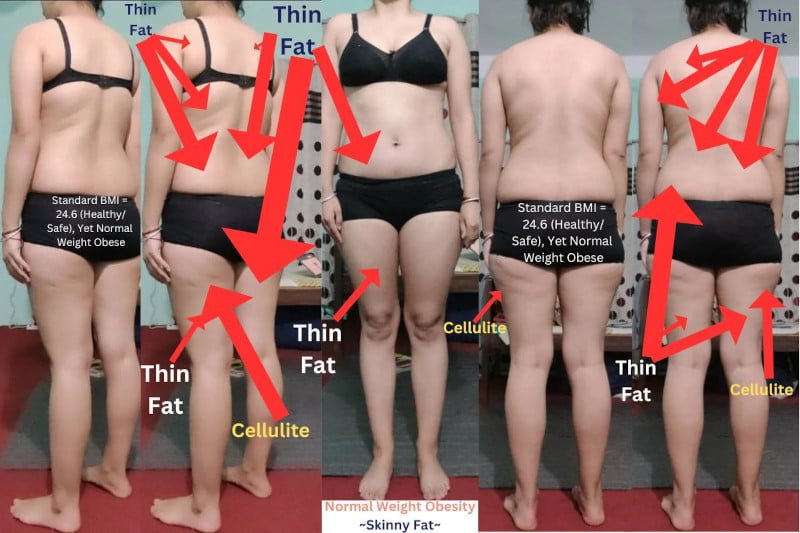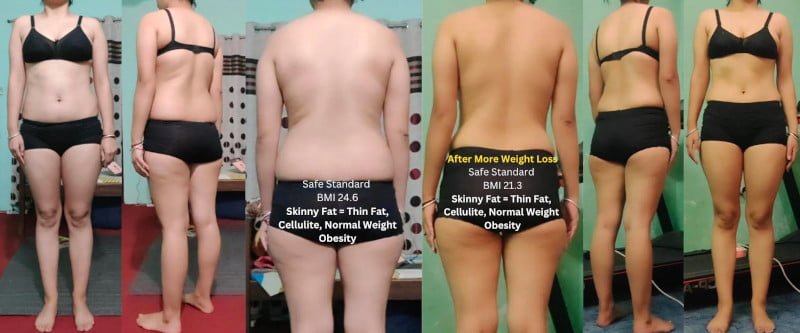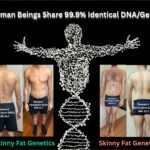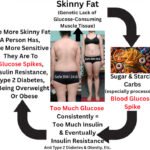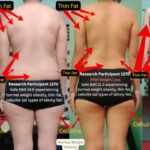Is Skinny Fat Genetic?

The common spiel everywhere but particularly online, especially on Google and social media, is that skinny fat is caused by poor diet and exercise, not genetics. What does the latest science say? Is skinny fat genetic?
There is no debate that a poor diet and deficient protein can lead to muscle tissue loss. Just as insufficient exercise and being too sedentary can also result in lost muscle tissue. The widespread claim is that lost muscle tissue causes skinny fat.
How would that work?
Muscle is unique tissue (1, 2, 3). When muscle tissue is lost, it cannot and does not (4, 5, 6, 7) turn into some other unique tissue, like regular white/yellow body fat/adipose tissue (8, 9, 10, 11). For instance, here is genetically blessed Christian Bale (BT1)(12) when he lost a significant amount of weight including obvious muscle tissue. According to common spiel everywhere, he should be experiencing skinny fat.
But he is not. He is showing no signs of skinny fat. Even when emaciated, he has clear muscle definition, as per the Standard Body Type One (BT1)(13).
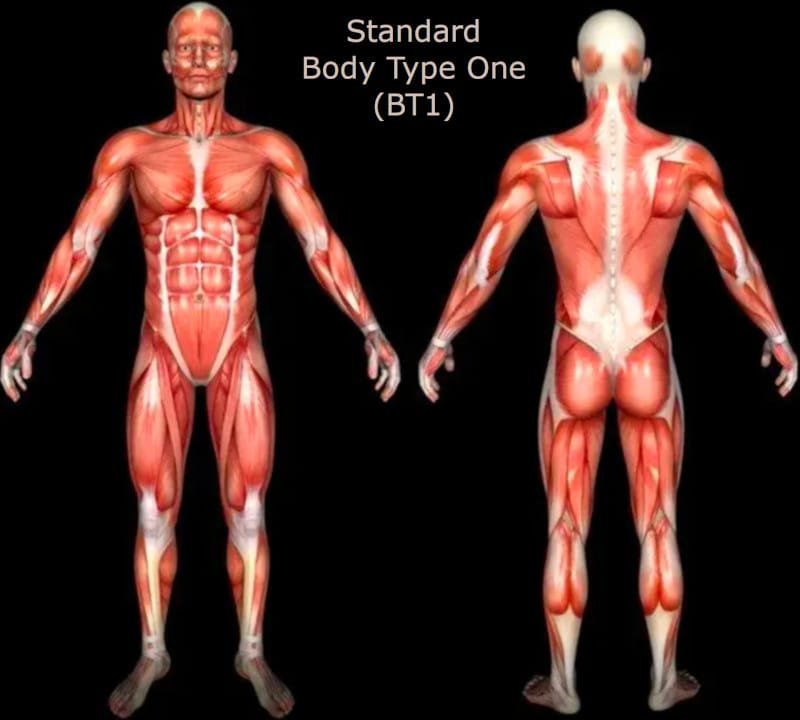
If it is true that lost muscle tissue causes skinny fat, then that truth applies universally and unequivocally to all human beings. So, why did Christian Bale clearly lose muscle tissue yet he is not experiencing skinny fat? Because as a genetically blessed Standard BT1, he has all 600+ muscles developed from birth. Genetics.
Just as hypotonia (46) and Poland Syndrome (47, 48) are genetic muscle disorders.
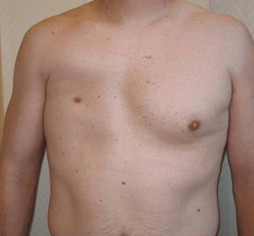


Is Skinny Fat Genetic?
It is a fact (14, 15, 16, 17, 18, 19) that the total amount of genetic default muscle tissue — including the number of Type 1 and Type 2 muscle fibers (20, 21, 22, 23, 24) — each human being has is set at or around birth. Just as it is a fact that some people have more genetic default muscle/mass from birth, while others have less genetic default muscle/mass from birth. The ratio of muscle fibers each specific person has from birth directly affects how easy or hard it is for them to add (25, 26, 27, 28) muscle mass via proper exercise and maintain it.
Of course, it is very possible to epigenetically add muscle mass (above and beyond default genetic muscle/mass) through exercise, particularly resistance exercise like weight lifting. But, adding muscle mass is not permanent (29, 30, 31, 32, 33, 34, 35, 36, 37, 38, 39).
This professional trainer and amateur athlete is within safe BMI (18.5 to 24.99) at 22.7:
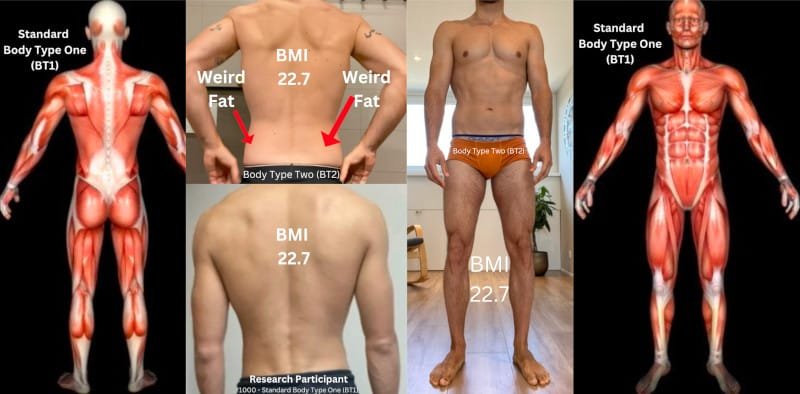
They have no excess body fat (regular white/yellow fat/adipose tissue), no visceral fat, no belly, and do not have a low amount of muscle/mass tissue — all of which, according to Google, is how skinny fat is defined.
Yet, they have obvious “weird fat” tissue on their love handles and lower back where genetically they should have default genetic muscle/mass:
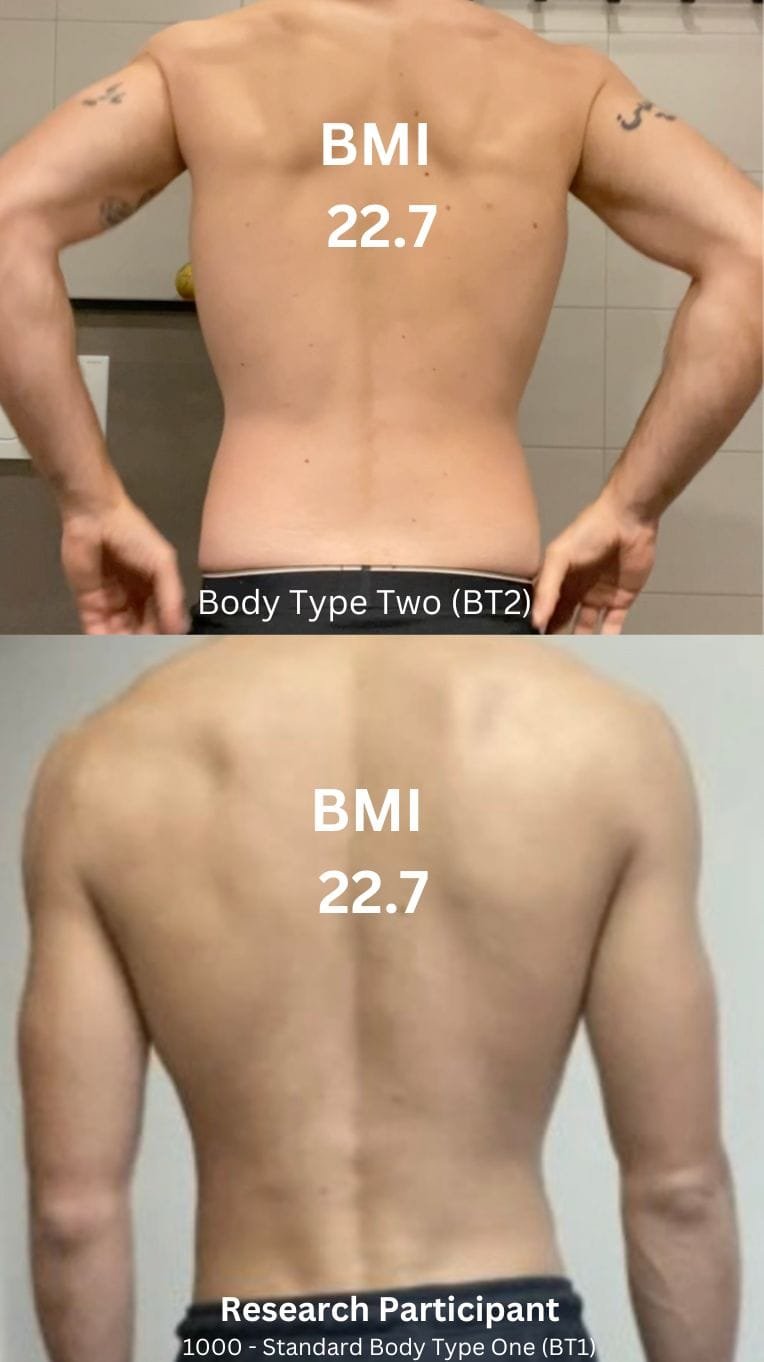
Is Skinny Fat Real, Unique Genetic Tissue?

By Standard BT1 definition, they should genetically have default genetic muscle/mass tissue on their love handles and lower back, just like research participant 1000 (40) — but they do not. We know they are within safe BMI at 22.7 and by Standard BMI definition they do not have any excess regular white/yellow body fat — so the “weird fat” on their love handles and lower back is not regular body fat. In fact, they could lose even more regular fat weight and get down to a minimum safe BMI of 18.5 and the genetic default muscle/mass would not magically appear on their love handles and lower back.
Their diet, exercise, and lifestyle routines are healthy (as verified by their doctor and the Scientific Health Quizzes). But, even if their routines were not healthy, we know it is an undisputed fact (4, 5, 6, 7) that lost muscle tissue cannot and does not magically turn into any kind of fat tissue (regular fat, brown fat, beige fat, skinny fat). No process exists in the human body for that to happen.
The “weird fat” on their love handles and lower back (why only on their love handles and lower back?) is unique genetic skinny fat tissue (41) — IE lack of/underdeveloped genetic muscle tissue. In this case, thin fat tissue. They have had it since birth. Skinny fat is unique genetic tissue that exists where genetic default muscle/mass should be, but is not. Skinny fat is not caused by diet or exercise, although metabolism (42), diet (43), exercise (44), and lifestyle (45) directly influence skinny fat.
How To Determine If You Have Genetic Skinny Fat Tissue
The Scientific Body Type Quiz (Official) was developed to accurately determine and identify if you have genetic skinny fat tissue.
Along with the other Scientific Health Quizzes — Scientific Metabolism Quiz, Scientific Diet Quiz, Scientific Exercise Quiz, and Scientific Lifestyle Quiz — you can accurately calculate your unique metrics to understand your unique genetic body composition and health.
References
- Cleveland Clinic: Muscles, January 23, 2024. https://my.clevelandclinic.org/health/body/21887-muscle
- ScienceDirect: Muscle Tissue, 2011. https://www.sciencedirect.com/topics/agricultural-and-biological-sciences/muscle-tissue
- MedlinePlus: Types of muscle tissue, January 25, 2023. https://medlineplus.gov/ency/imagepages/19841.htm
- LiveScience: Can You Turn Fat into Muscle?, November 10, 2017, Ashley P. Taylor. https://www.livescience.com/60904-can-you-turn-fat-into-muscle.html
- NIH, National Library of Medicine: Muscle-to-fat interaction: a two-way street?, January 1, 2010, Bente K Pedersen. https://pmc.ncbi.nlm.nih.gov/articles/PMC2821541/
- Healthline: Does Fat Turn into Muscle? What to Know, March 2, 2021, Katey Davidson, MScFN, RD, CPT (Medically reviewed by Jake Tipane, CPT). https://www.healthline.com/nutrition/does-fat-turn-into-muscle
- The New York Times: The Claim: Muscle Turns to Fat When You Stop Working Out, July 26, 2006, Anahad O’Connor. https://www.nytimes.com/2005/07/26/health/nutrition/the-claim-muscle-turns-to-fat-when-you-stop-working-out.html
- ScienceDirect: White Adipose Tissue, Trends in Endocrinology & Metabolism, 2006. https://www.sciencedirect.com/topics/medicine-and-dentistry/white-adipose-tissue
- Wikipedia: White adipose tissue, https://en.wikipedia.org/wiki/White_adipose_tissue
- NIH, National Library of Medicine: Fat tissues, the brite and the dark sides, October 4, 2016, Yong Chen, Ruping Pan, and Alexander Pfeifer. https://pmc.ncbi.nlm.nih.gov/articles/PMC5138267/
- Cleveland Clinic: Adipose Tissue (Body Fat), August 18, 2022. https://my.clevelandclinic.org/health/body/24052-adipose-tissue-body-fat
- Fellow One Research: Christian Bale Physique – Celebrity Body Type One (BT1), Male. https://www.fellowone.com/fellow-one-research/the-four-body-types/celebrity-body-types/christian-bale/celebrity-body-type-one/
- Britannica: human muscle system, Shane W. Cummings and Robin Huw Crompton (Fact-checked by the Editors of Encyclopaedia Britannica. https://www.britannica.com/science/human-muscle-system
- Nature, Communications: Pericytes resident in postnatal skeletal muscle differentiate into muscle fibres and generate satellite cells, October 11, 2011, A. Dellavalle, G. Maroli, D. Covarello, E. Azzoni, A. Innocenzi, L. Perani, S. Antonini, R. Sambasivan, S. Brunelli, S. Tajbakhsh, and G. Cossu. https://www.nature.com/articles/ncomms1508/
- ScienceDirect, Muscle Growth: Muscle Structure and Function, 2017, C.-n. (Joyce) Chen PT, PhD and L.A. Snow MD, PhD in Orthopaedic Physical Therapy Secrets (Third Edition). https://www.sciencedirect.com/topics/biochemistry-genetics-and-molecular-biology/muscle-growth/
- NIH, National Library of Medicine: Not all the number of skeletal muscle fibers is determined prenatally, Mingsen Li, Xingyu Zhou, Yaosheng Chen, Yaping Nie, Huaxing Huang, Hu Chen, and Delin Mo. https://pmc.ncbi.nlm.nih.gov/articles/PMC4642764/
- ScienceDirect: Muscle Development, 2016, The Molecular Nutrition of Amino Acids and Proteins. https://www.sciencedirect.com/topics/agricultural-and-biological-sciences/muscle-development/
- NIH, National Library of Medicine: Muscle Cell Growth and Development, Ronald E. Allen. https://www.ncbi.nlm.nih.gov/books/NBK218163/
- NIH, National Library of Medicine: Genesis, Modulation, and Regeneration of Skeletal Muscle, 2002, Bruce Alberts, Alexander Johnson, Julian Lewis, Martin Raff, Keith Roberts, and Peter Walter. https://www.ncbi.nlm.nih.gov/books/NBK26853/
- NIH, National Library of Medicine: Muscle fiber types, May 1982, G J Herbison, M M Jaweed, and J F Ditunno. https://pubmed.ncbi.nlm.nih.gov/6462127/
- Ace Fitness: Muscle Fiber Types: Fast-Twitch vs. Slow-Twitch, October 30, 2015, Pete McCall. https://www.acefitness.org/resources/pros/expert-articles/5714/muscle-fiber-types-fast-twitch-vs-slow-twitch/
- Oxford Academic, Physical Therapy and Rehabilitation Journal (PTJ): Human Skeletal Muscle Fiber Type Classifications, November 1, 2001, W Scott, PT, MPT, J Stevens, PT, MPT, and SA Binder-Macleod, PT, PhD. https://academic.oup.com/ptj/article-abstract/81/11/1810/2857618?redirectedFrom=fulltext
- Wikipedia: Skeletal muscle. https://en.wikipedia.org/wiki/Skeletal_muscle
- NASM: Fast-Twitch Vs. Slow-Twitch Muscle Fiber Types + Training Tips, Nicole Golden. https://blog.nasm.org/fitness/understanding-fast-twitch-vs-slow-twitch-mucle-fibers
- Northwestern Now: Gene’s role in attaining and maintaining muscle mass revealed, February 13, 2024, Win Reynolds. https://news.northwestern.edu/stories/2024/02/bcl6-gene-role-in-muscle-revealed/
- NIH, National Library of Medicine: Genetic influences on muscle strength, lean body mass, and bone mineral density: a twin study, December 1997, N K Arden and T D Spector. https://pubmed.ncbi.nlm.nih.gov/9421240/
- NIH, National Library of Medicine: Transcriptional programming of translation by BCL6 controls skeletal muscle proteostasis, February 6, 2024, Krithika Ramachandran, Christopher R Futtner, Meredith A Sommars, Mattia Quattrocelli, Yasuhiro Omura , Ellen Fruzyna 1 , Janice C Wang, Nathan J Waldeck , Madhavi D Senagolage, Carmen G Telles , Alexis R Demonbreun , Erin Prendergast , Nicola Lai 7 , Daniel Arango , Ilya R Bederman , Elizabeth M McNally, and Grant D Barish. https://pubmed.ncbi.nlm.nih.gov/38337096/
- MedlinePlus: Myostatin-related muscle hypertrophy. https://medlineplus.gov/genetics/condition/myostatin-related-muscle-hypertrophy/
- Healthline: Exercise Break: How Long Does It Take to Lose Muscle Mass?, November 1, 2018, Lindsay Ross-Hazel. https://www.healthline.com/health/how-long-does-it-take-to-lose-muscle-mass
- Muscle and Fitness: How Long Does It Take to Start Losing Muscle After You Stop Working Out?, Mark Lelinwalla. https://www.muscleandfitness.com/athletes-celebrities/news/how-long-does-it-take-start-losing-muscle-after-you-stop-working-out/
- Eat This, Not That!: Here’s How Fast You’ll Lose Muscle If You Stop Exercising, May 31, 2024, Jarrod Nobbe, MA, CSCS (Fact-checked by Alexa Mellardo). https://www.eatthis.com/how-fast-you-lose-muscle-from-exercise-break/
- NIH, National Library of Medicine: Factors That Influence Body Weight, https://www.ncbi.nlm.nih.gov/books/NBK221834/
- UC Berkeley, Retirement Center: Muscle Mass Can Decline 25% In As Little As 2 Weeks … But We Can Get It Back!, July 2022, Cary Sweeney. https://retirement.berkeley.edu/publications/muscle-mass-can-decline-25-little-2-weeks-we-can-get-it-back
- Global News: If you stop exercising, here’s how quickly you’ll lose strength, July 20, 2019, Laura Hensley. https://globalnews.ca/news/5653575/how-long-does-it-take-to-lose-muscle-mass/
- Shape: How Long Does It Take to Lose Muscle?, July 28, 2022, Megan Falk. https://www.shape.com/fitness/workouts/strength-training/how-long-does-it-take-to-lose-muscle
- NIH, National Library of Medicine: Substantial skeletal muscle loss occurs during only 5 days of disuse, March 2014, B T Wall, M L Dirks, T Snijders, J M G Senden, J Dolmans, and L J C van Loon. https://pubmed.ncbi.nlm.nih.gov/24168489/
- MVPT Physical Therapy: How Long It Takes to Build and Lose Muscle, https://mvpt-physicaltherapy.com/how-long-it-takes-to-build-and-lose-muscle/
- Harvard Health Publishing: Don’t let muscle mass go to waste, April 10, 2023, Matthew Solan (Reviewed by Howard E. LeWine, MD, Chief Medical Editor). https://www.health.harvard.edu/staying-healthy/dont-let-muscle-mass-go-to-waste
- Fellow One Research: Research Participant 378 – Body Type Two (BT2) Male (Man), Millennial (Generation Y). https://www.fellowone.com/fellow-one-research/the-four-body-types/body-type-quiz/research-participant-378-body-type-two-bt2-male-man-millennial-generation-y/
- Fellow One Research: Body Type Test (Quiz) Results 1000 – Body Type One (BT1) Male (Man), Millennial (Generation Y). https://www.fellowone.com/fellow-one-research/the-four-body-types/body-type-quiz/body-type-test-quiz-results-1000-body-type-one-bt1-male-man-millennial-generation-y/
- Skinny Fat Science: What Is Skinny Fat?, July 26, 2024. https://skinnyfat.fellowone.com/what-is-skinny-fat/
- Skinny Fat Science: How Skinny Fat Affects Metabolism, August 7, 2024. https://skinnyfat.fellowone.com/how-skinny-fat-affects-metabolism/
- Skinny Fat Science: The Best Skinny Fat Diet, According to Science, July 29, 2024. https://skinnyfat.fellowone.com/the-best-skinny-fat-diet-according-to-science/
- Skinny Fat Science: The Best Skinny Fat Exercise, According to Science, August 2, 2024. https://skinnyfat.fellowone.com/the-best-skinny-fat-exercise-according-to-science/
- Skinny Fat Science: The Best Skinny Fat Lifestyle, According to Science, August 14, 2024. https://skinnyfat.fellowone.com/the-best-skinny-fat-lifestyle-according-to-science/
- Wikipedia: Hypotonia. https://en.wikipedia.org/wiki/Hypotonia
- National Institutes of Health (United States Department of Health and Human Services) – National Center For Advancing Translational Sciences, Genetic and Rare Diseases Information Center: Poland syndrome, https://rarediseases.info.nih.gov/diseases/7412/poland-syndrome
- Wikipedia: Poland syndrome. https://en.wikipedia.org/wiki/Poland_syndrome



